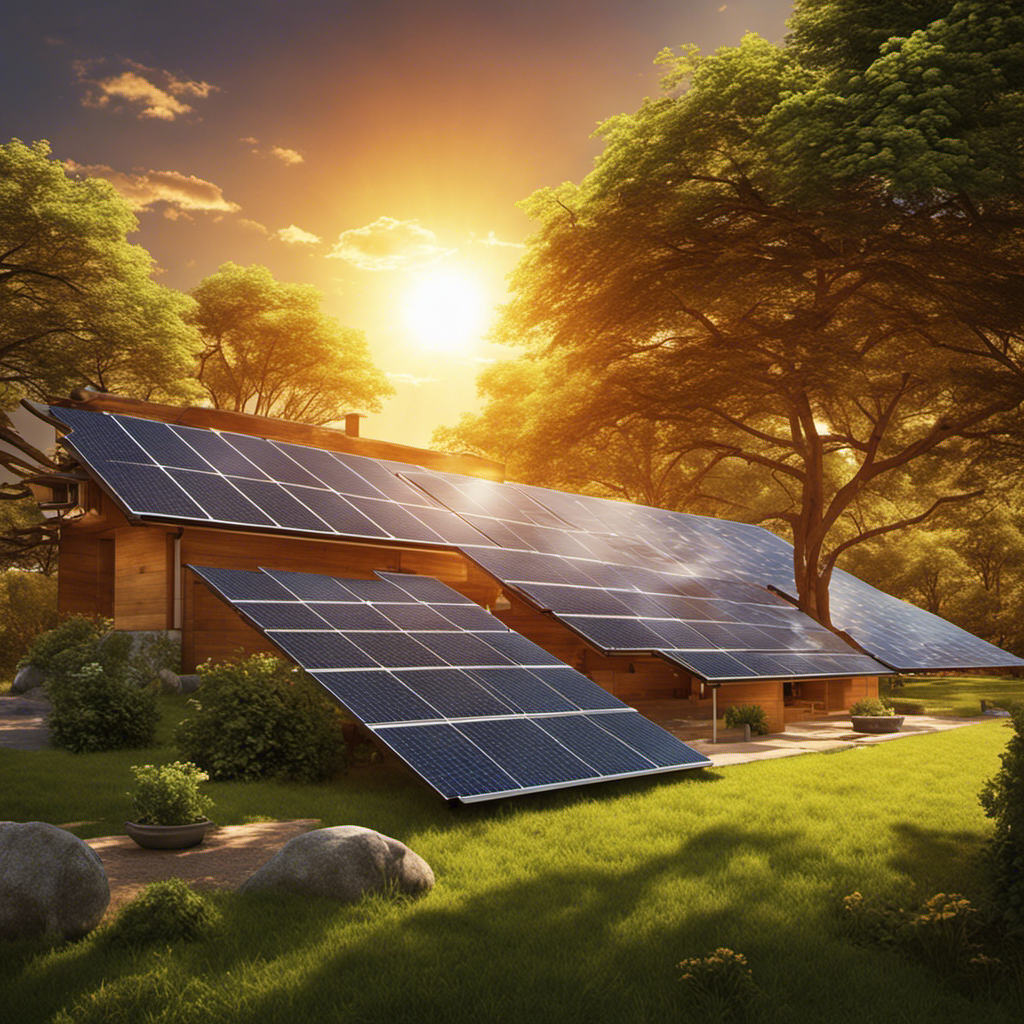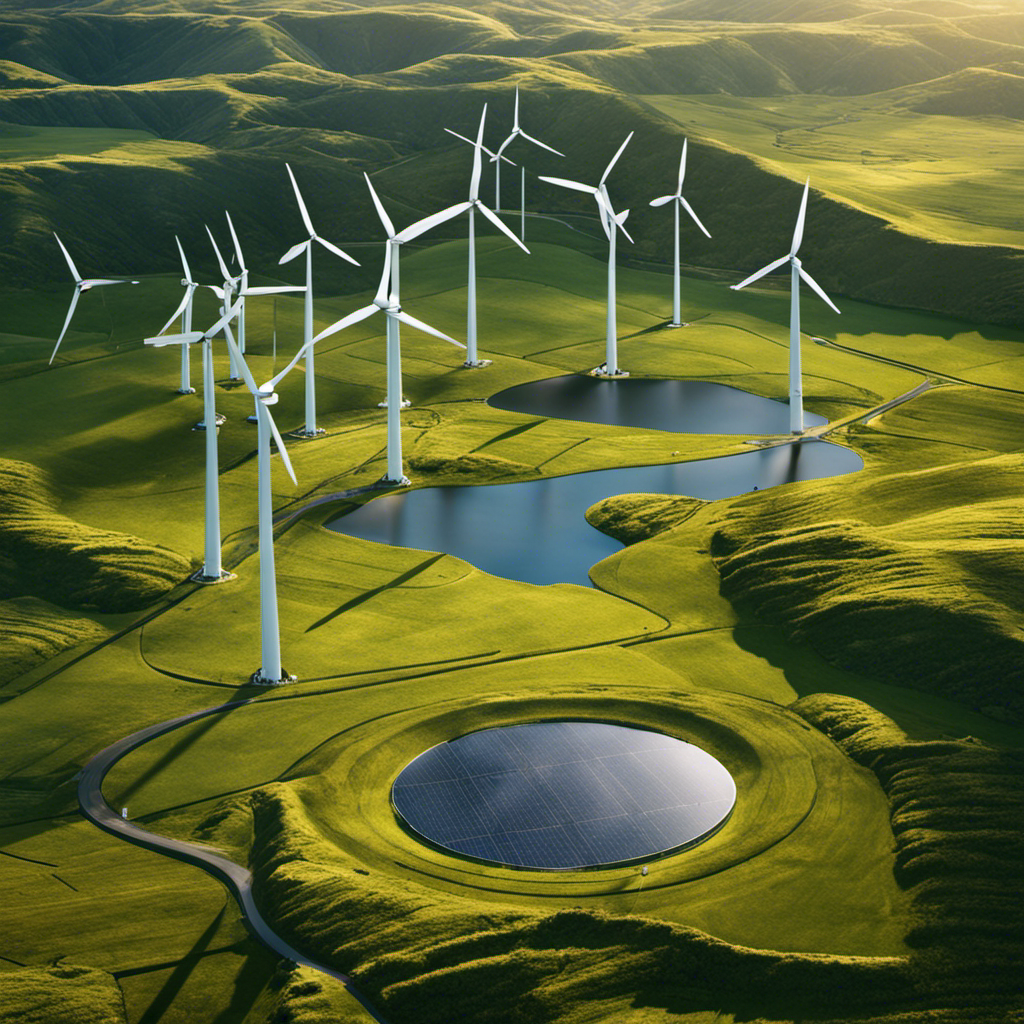Geothermal
Unleashing the Power of Geothermal Energy

I’ve long been captivated by the untapped possibilities of geothermal energy. This renewable resource has been harnessed for centuries, yet now is the moment to deploy its capabilities more broadly.
With 5,157 gigawatts of estimated resources in the US alone, geothermal energy has the ability to revolutionize our energy landscape. Not only is it clean and predictable, but it also has the potential to reduce carbon dioxide emissions by up to 85%.
In this article, we’ll explore how harnessing geothermal power can lead to job creation, economic growth, and a more sustainable future.
Key Takeaways
- Geothermal power is a reliable and clean source of renewable energy that can be used for baseload power 24 hours a day.
- Geothermal energy has significant potential in the US, with estimated resources five times greater than current installations.
- Geothermal power has environmental benefits, including reducing carbon dioxide emissions by up to 85% and offsetting other pollutants.
- Geothermal energy can contribute to economic growth through job creation and supporting industrial and residential energy needs.
The Potential of Geothermal Energy
I believe that geothermal energy has immense potential to be a game-changer in our pursuit of sustainable and clean energy solutions.
Geothermal energy exploration and utilization are key to unlocking this potential. Geothermal energy is derived from the heat stored within the Earth’s crust. By tapping into this renewable resource, we can generate electricity and heat without relying on fossil fuels.
The process involves drilling deep into the Earth to reach hot water or steam reservoirs, which are then used to power turbines and generate electricity. Geothermal energy utilization extends beyond electricity generation. It can also be harnessed for heating purposes, such as heating homes, pools, and even drying timber.
With its abundant reserves and minimal environmental impact, geothermal energy has the capability to revolutionize the way we produce and consume energy.
Harnessing Geothermal Power for Electricity Generation
Harnessing heat from beneath the Earth’s surface can be a reliable and sustainable method for generating electricity. Geothermal energy technology advancements and geothermal power plant efficiency improvements have made it even more promising.
With advancements in drilling techniques and reservoir management, geothermal power plants are becoming more efficient in converting heat energy into electricity. These improvements have increased the overall efficiency and productivity of geothermal power plants, making them a viable option for clean energy generation.
Additionally, advancements in geothermal energy technology have led to the development of binary power plants, which can utilize lower temperature resources that were previously untapped. These advancements not only increase the potential for geothermal energy utilization but also contribute to the overall growth of the renewable energy sector.
Environmental Advantages of Geothermal Energy
Utilizing the Earth’s natural heat for electricity generation presents numerous environmental benefits. It reduces carbon emissions and minimizes air pollution. Geothermal energy plays a crucial role in sustainable development and has a significant impact on climate change. Here are four key reasons why geothermal energy is advantageous for the environment:
- Geothermal power plants produce minimal greenhouse gas emissions, making them a clean energy source.
- By utilizing geothermal energy, we can reduce our reliance on fossil fuels, which contribute to climate change.
- Geothermal power plants do not release harmful pollutants into the air, improving air quality and reducing respiratory health issues.
- Geothermal energy is a renewable resource that can be sustained for future generations. It promotes long-term sustainability and minimizes environmental impact.
Integrating Geothermal Energy Into Communities
Implementing geothermal energy into communities can provide reliable and affordable electricity and heating options for homes and businesses. Geothermal energy has great potential to be integrated into urban areas through community-based projects. By utilizing the natural heat from the Earth’s core, geothermal energy can be harnessed to power homes and provide heating solutions.
To illustrate the benefits of community-based geothermal projects, consider the following table:
| Benefits of Geothermal Energy in Urban Areas | Community-Based Geothermal Projects |
|---|---|
| Reliable and continuous power supply | Reduced reliance on fossil fuels |
| Reduced greenhouse gas emissions | Local job creation |
| Lower energy costs for residents | Increased energy independence |
| Stable and predictable energy source | Enhanced local economy |
| Improved air quality | Sustainable development |
Community-based geothermal projects not only provide clean energy solutions but also contribute to the economic growth of the community by creating employment opportunities and reducing energy costs. By implementing geothermal energy in urban areas, communities can achieve a sustainable and environmentally friendly future.
Job Creation and Economic Growth From Geothermal Power
Investing in geothermal power projects can stimulate job creation and foster economic growth in local communities. Geothermal energy has the potential to provide significant opportunities for employment and contribute to economic development. Here are four key ways in which geothermal power can drive job creation and economic growth:
-
Job Opportunities: Geothermal projects create employment opportunities in the renewable energy sector, including roles in exploration, drilling, plant construction, and operation.
-
Local Economy Boost: Geothermal energy can contribute to the local economy by attracting investments, supporting local businesses, and generating revenue through power sales.
-
Technological Advancements: Startups are emerging to provide the necessary technology for geothermal projects, driving innovation and creating new job opportunities in research and development.
-
Energy Independence: Geothermal power can help communities overcome energy challenges and reduce dependence on conventional fuels, leading to long-term economic stability and growth.
Geothermal Power Generation: Statistics and Flexibility
I was amazed to learn that in 2020, geothermal power generated 225 TWh of electricity globally. This showcases the growing importance of geothermal power generation in meeting our energy needs. Geothermal power plants play a crucial role in integrating renewable energy into the grid. They provide a reliable and flexible source of electricity that can be adjusted to meet changing demand.
To better understand the global trends in geothermal power generation, let’s take a look at the following table:
| Global Geothermal Power Generation (2020) | Electricity Generated (TWh) |
|---|---|
| United States | 17 |
| Other Countries | 97 |
| Total Global Generation | 225 |
As we can see, the United States generated 17 TWh of geothermal electricity, making it one of the top non-hydroelectric sources of renewable electricity. Furthermore, other countries contributed 97 TWh to the global geothermal power generation.
This data highlights the significant role that geothermal power plants play in the integration of renewable energy sources. By harnessing the Earth’s natural heat, geothermal power generation contributes to a sustainable and green energy future.
Geothermal Energy for Industrial Purposes
Geothermal power can be harnessed for various industrial applications, including providing heat for manufacturing processes and powering machinery.
Geothermal energy can be used in agriculture to create favorable growing conditions for crops, such as maintaining greenhouse temperatures or providing heat for drying agricultural products.
Geothermal energy can be utilized in manufacturing processes, such as heating substances for chemical reactions or powering industrial machinery.
The consistent and reliable nature of geothermal energy makes it an ideal choice for industrial applications, eliminating the need for intermittent energy sources.
Utilizing geothermal energy in these sectors not only reduces greenhouse gas emissions but also helps to lower operational costs for businesses.
Overcoming Energy Challenges With Geothermal Power
In my previous discussion on geothermal energy for industrial purposes, I highlighted the versatile applications of this renewable resource. Now, let’s explore how geothermal power can help in overcoming energy challenges, particularly in the context of sustainable development and the fight against energy poverty.
Geothermal energy has the potential to play a crucial role in providing clean and reliable power to communities that lack access to electricity. By tapping into the Earth’s natural heat, geothermal power can ensure a constant energy supply, thereby improving the quality of life for individuals and promoting economic development.
One of the key advantages of geothermal energy is its sustainability. Unlike fossil fuels, which are finite and contribute to climate change, geothermal power is a renewable resource that can be harnessed for the long term. By utilizing this abundant and clean energy source, we can reduce our dependence on conventional fuels and mitigate the harmful effects of greenhouse gas emissions.
Moreover, geothermal energy offers a viable solution for regions facing energy poverty. These areas often lack reliable access to electricity, hindering their social and economic progress. By investing in geothermal infrastructure, governments and organizations can bring affordable and sustainable power to underserved communities, fostering inclusive development and reducing disparities.
Unleashing the Economic Potential of Geothermal Energy
By tapping into the economic potential of geothermal resources, we can create job opportunities and drive sustainable growth in local communities. Maximizing geothermal resources requires implementing effective geothermal energy policies and incentives. Here are four key factors to consider:
-
Government support: Implementing supportive policies and incentives can encourage investment in geothermal projects, leading to increased economic activity and job creation.
-
Technology development: Continued research and development in geothermal technology can unlock the full potential of geothermal resources, making them more accessible and cost-effective.
-
Collaboration with industries: Engaging with industries such as engineering, construction, and manufacturing can foster innovation and create new opportunities for economic growth.
-
Community engagement: Involving local communities in the planning and development of geothermal projects can ensure that the economic benefits are shared equitably and contribute to the overall well-being of the community.
Frequently Asked Questions
What Are Some Examples of Geothermal Energy Usage in Ancient Times?
Geothermal energy in ancient times was utilized for heating food and water. It was a reliable source of heat that provided comfort and sustenance to ancient civilizations.
Today, we can see the influence of geothermal energy in modern architecture. It is used for heating and cooling homes, reducing energy consumption, and lowering carbon emissions.
Geothermal power has come a long way, from its ancient origins to its current role in shaping a sustainable and clean energy future.
How Many Geothermal Power Plants Are Currently Operating in the Us?
Currently, there are over 60 operating geothermal power plants in the US. These plants harness the power of geothermal energy to generate electricity and provide various benefits.
Geothermal energy is a clean and renewable source that reduces carbon emissions and can be used for baseload power 24/7. Its future prospects are promising, with estimated geothermal resources in the US being five times more than what is currently installed.
The expansion of geothermal energy can bring about significant environmental and economic benefits.
How Much Can Geothermal Energy Reduce Carbon Dioxide Emissions By?
Geothermal energy has the potential to significantly reduce carbon dioxide emissions. Studies show that geothermal power can reduce CO2 emissions by up to 85%. This makes it a valuable tool in the fight against climate change.
What Are Some Examples of the Employment Opportunities Created by Geothermal Projects?
There are several employment opportunities created by geothermal projects. In the geothermal energy sector, jobs can be found in various fields such as drilling, exploration, power plant construction, and operation.
Additionally, there is a growing demand for skilled professionals in geothermal research, development, and engineering. The renewable energy industry is experiencing rapid growth, and geothermal power offers a promising avenue for job creation and economic growth in regions with geothermal resources.
How Much Geothermal Electricity Did the United States Generate in 2020 and What Rank Did It Hold Among Non-Hydroelectric Sources of Renewable Electricity?
In 2020, the United States generated 17 TWh of geothermal electricity, ranking it as the seventh-largest non-hydroelectric source of renewable electricity.
Geothermal energy research and production technologies have played a crucial role in achieving this milestone.
With its reliable and flexible power generation capabilities, geothermal energy has the potential to contribute significantly to our energy needs while reducing our dependence on conventional fuels.
Conclusion
In conclusion, geothermal energy is a highly promising renewable resource that has the power to revolutionize our energy landscape.
With the US estimated to have a staggering 5,157 gigawatts of geothermal resources, we have the potential to tap into a clean and reliable energy source that is five times greater than our current capacity.
Not only does geothermal power reduce carbon dioxide emissions by up to 85%, but it also has the ability to create employment opportunities and contribute to economic growth.
With global geothermal power generation reaching 225 TWh in 2020, it is evident that this renewable energy source is gaining momentum.
By harnessing the flexibility of geothermal power plants and integrating them with other renewable sources, we can make significant strides in achieving sustainable development and reducing our dependence on conventional fuels.
Let’s unleash the economic potential of geothermal energy and pave the way for a greener future.
Geothermal
Geothermal Power: A Clean and Location-Specific Energy Source

I’ve always been captivated by the immense force that resides below our planet’s crust. Geothermal energy, a sustainable and environmentally friendly option, harnesses this amazing power.
It’s location-specific, relying on underground reservoirs for heat and electricity generation. Geothermal power plants boast high availability rates and produce minimal carbon dioxide emissions, making them a green alternative.
While there are potential drawbacks like subsidence and earthquakes, the advantages of geothermal power are undeniable.
Join me as we explore the potential of this clean and location-specific energy source.
Key Takeaways
- Geothermal power is a renewable and clean source of energy.
- Geothermal energy is location-specific and requires access to underground reservoirs.
- Geothermal energy can be used for both electricity generation and heating.
- Geothermal power plants have been in operation for over a century and can be harnessed globally.
The Renewable and Clean Nature of Geothermal Power
Geothermal power is a renewable and clean energy source that I find fascinating. The advantages of geothermal energy are numerous, particularly in terms of its environmental benefits.
Geothermal power plants produce almost no carbon dioxide emissions, making them a clean alternative to fossil fuels. Additionally, geothermal fields have high availability rates, ensuring a reliable source of energy. This renewable natural source is not only sustainable but also reduces dependence on non-renewable energy sources.
Geothermal energy is a green solution that can help mitigate climate change and reduce air pollution. By harnessing the heat stored within the earth’s core, geothermal power can provide electricity and heat without contributing to greenhouse gas emissions. Its potential to diversify the electric supply and its environmentally friendly nature make geothermal energy an attractive option for a sustainable future.
Geothermal Power Plants and Their Low Carbon Footprint
I love how geothermal power plants have such a low carbon footprint.
Geothermal energy is a sustainable heating solution that offers numerous environmental benefits.
Unlike traditional power plants, geothermal plants produce almost no carbon dioxide emissions during operation. This is because they harness the natural heat stored within the Earth’s core, which eliminates the need for burning fossil fuels.
Additionally, geothermal power plants have high availability rates, making them a reliable and consistent source of energy.
The use of geothermal energy as a heating solution is also highly efficient, as it utilizes natural underground sources to produce steam for generating electricity.
Overall, geothermal power plants are an excellent choice for reducing greenhouse gas emissions and promoting a greener and more sustainable future.
High Availability Rates of Geothermal Power Plants
The high availability rates of these plants make them a reliable and consistent source of electricity. Geothermal power plants have proven to be highly reliable in terms of their operational performance. This is primarily attributed to the fact that geothermal resources are naturally replenished and can provide a continuous supply of heat to generate electricity.
Additionally, geothermal power plants require minimal maintenance compared to other forms of power generation. The maintenance costs associated with geothermal power plants are relatively low, making them economically attractive.
Furthermore, the economics of geothermal power plants are favorable due to their long operational lifespan and low fuel costs. The abundance of geothermal resources in certain regions also contributes to the economic viability of geothermal power plants.
Overall, the high availability rates, low maintenance requirements, and favorable economics make geothermal power plants a promising and sustainable option for electricity generation.
Geothermal Energy as a Green Alternative in Industry
As an environmentally conscious option, geothermal energy offers industries a green alternative for their power needs. Here are three reasons why geothermal energy is beneficial in reducing carbon emissions and powering manufacturing processes:
-
Geothermal power in manufacturing processes:
-
Geothermal energy can be utilized in various manufacturing processes, such as heating, cooling, and drying.
-
This renewable energy source can provide a constant and reliable power supply, ensuring consistent production output.
-
By replacing traditional fossil fuel-based energy sources with geothermal power, industries can significantly reduce their carbon footprint.
-
Geothermal energy in reducing carbon emissions in industries:
-
Geothermal power plants produce almost no carbon dioxide emissions during operation.
-
By utilizing geothermal energy, industries can directly decrease their greenhouse gas emissions.
-
Switching to geothermal power can contribute to achieving sustainability goals and meeting environmental regulations.
A Century of Geothermal Power Plant Operations
Throughout the past century, geothermal power plants have been successfully operating and providing a reliable source of electricity.
The advantages of geothermal power plant operations are numerous. Geothermal energy is a renewable and clean source of energy that produces almost no carbon dioxide emissions. Geothermal power plants also have high availability rates, ensuring a consistent supply of electricity.
However, there are some drawbacks to consider. Geothermal power plants require access to specific underground reservoirs, limiting their geographical locations. Additionally, these power plants can cause subsidence and earthquakes in some cases.
Looking to the future, advancements in geothermal power plant technology hold great promise. Improved drilling techniques and enhanced geothermal systems could expand the potential for geothermal energy production, making it an even more viable and sustainable option for electricity generation.
Geothermal Power: Uniquely Location-Specific
I find it fascinating that geothermal plants require access to specific underground reservoirs. This unique requirement makes geothermal power a location-specific energy source. Here are some interesting points about geothermal power and its impact:
-
Environmental Impact:
-
Geothermal power produces almost no carbon dioxide emissions, making it a clean energy source.
-
Geothermal plants have high availability rates, meaning they can provide a consistent and reliable energy supply.
-
Geothermal energy is a green alternative in industry, reducing the reliance on fossil fuels and decreasing pollution.
-
Economic Feasibility:
-
Geothermal power plants can diversify the electric supply, reducing dependence on conventional sources.
-
Geothermal energy is a renewable natural source, providing long-term energy security.
-
Geothermal power has the potential to create jobs and stimulate local economies in areas with suitable resources.
Overall, geothermal power offers both environmental and economic benefits, making it a promising energy option for the future.
Accessing Underground Reservoirs for Geothermal Plants
Drilling deep wells allows access to the underground reservoirs needed for geothermal plants. These reservoirs contain hot water or steam that can be used to generate electricity.
With advancements in geothermal plant technology, accessing these underground reservoirs has become more efficient and cost-effective. One such advancement is the use of directional drilling techniques, which enable the drilling of wells at specific angles to reach the reservoirs more accurately.
Additionally, the development of advanced downhole sensors and monitoring systems allows for real-time data collection, ensuring optimal well placement and reservoir management.
These technological advancements have not only improved the efficiency of geothermal power generation but have also expanded the potential for geothermal energy development in various regions around the world.
Geothermal Energy for Heating and Industrial Processes
Accessing underground reservoirs for geothermal plants allows for the utilization of hot water or steam in heating and industrial processes, contributing to the reduction of carbon emissions. Geothermal energy has numerous applications, including district heating and agricultural processes, making it an effective and sustainable option.
Here are three key benefits of geothermal energy in these areas:
-
Geothermal energy for district heating:
-
Geothermal power can provide reliable and efficient heating for entire communities.
-
It reduces the reliance on fossil fuels, lowering greenhouse gas emissions.
-
District heating systems utilizing geothermal energy are cost-effective in the long run.
-
Geothermal energy for agricultural processes:
-
Geothermal heat can be used for greenhouse heating, enhancing crop growth and productivity.
-
It enables year-round cultivation, regardless of external weather conditions.
-
Geothermal energy in agriculture promotes sustainable practices and reduces the industry’s carbon footprint.
Geothermal Resources Along Tectonic Plate Borders
Located along tectonic plate borders, the natural resources found underground can be harnessed for various purposes. Geothermal resources exploration is a crucial aspect of uncovering the potential of geothermal energy. By studying the geological features and characteristics of these regions, we can assess the viability of extracting geothermal energy.
This involves conducting surveys and tests to determine the temperature, permeability, and fluid content of the underground reservoirs. These data-driven assessments enable us to understand the geothermal energy potential of a particular area.
Through the utilization of advanced drilling techniques, we can tap into these resources and harness the heat stored within the Earth’s core. This presents an opportunity to transition towards a renewable and sustainable energy source, reducing our reliance on fossil fuels and mitigating environmental impact.
Efficiency of Geothermal Systems
Moving on from the previous subtopic, let’s delve into the efficiency of geothermal systems. Geothermal energy has proven to be an efficient source of clean and renewable energy. Here are some key points to consider:
- Geothermal systems have high energy conversion rates, making them more efficient than fossil fuel-based power plants.
- The efficiency of geothermal power plants can reach up to 90%, surpassing most other forms of electricity generation.
Geothermal energy can be harnessed for various applications, including bathing. Geothermal bathing is a practice that dates back to Paleolithic times, and the Romans famously used geothermal energy for bathing in Bath, England. Geothermal spas and hot springs provide a sustainable and enjoyable way to utilize this natural resource.
The use of geothermal energy for bathing promotes relaxation and well-being while reducing reliance on traditional heating methods.
With its impressive efficiency and potential for various applications, geothermal energy continues to prove itself as a valuable and sustainable source of power.
Geothermal Power: Harnessing Heat for Electricity and Heat
Utilizing the Earth’s heat for electricity and heating purposes has proven to be an efficient and sustainable method. Geothermal power, a clean and renewable energy source, has a minimal environmental impact, making it an ideal choice for sustainable development.
Geothermal energy is harnessed by extracting heat from the Earth’s core through deep wells. This heat is then used to generate electricity and heat water for various purposes. Geothermal power plants produce almost no carbon dioxide emissions, making them environmentally friendly. Additionally, geothermal energy can be utilized for heating, reducing the reliance on fossil fuels.
Frequently Asked Questions
How Long Has Geothermal Energy Been Used for Bathing?
Geothermal energy for bathing has a significant historical significance and is deeply rooted in cultural practices. It has been used for bathing since the Paleolithic times, making it one of the oldest known uses of geothermal energy. This demonstrates the long-standing recognition of the therapeutic benefits and warmth provided by geothermal hot springs.
The Romans, for instance, utilized geothermal energy for bathing in Bath, England as early as the first century CE. These practices highlight the enduring value and utilization of geothermal resources throughout history.
What Is the Oldest Geothermal District Heat System and Where Is It Located?
The oldest geothermal district heat system is located in France. It has been in operation for a long time.
Geothermal energy has been used for bathing since ancient times, including during the Paleolithic era.
The Romans even utilized geothermal energy for bathing in Bath, England, way back in the first century CE.
These historical uses of geothermal energy highlight its long-standing importance and versatility as a renewable energy source.
Can Geothermal Power Plants Cause Subsidence and Earthquakes?
Geothermal power plants can cause subsidence and earthquakes, which can have a significant impact on local communities.
The risks associated with geothermal power plants arise from the extraction of heat from the earth’s core and the injection of fluids back into the underground reservoirs.
These activities can lead to changes in the geological structure, resulting in subsidence and seismic activity.
It is crucial to carefully monitor and manage these potential risks to ensure the safe and sustainable operation of geothermal power plants.
What Are Some Advantages of Geothermal Power?
Advantages of geothermal power include its potential for scalability and economic benefits.
For instance, the use of geothermal energy in the city of Reykjavik, Iceland has led to significant cost savings and reduced carbon emissions. Geothermal power plants in this region provide heating and electricity to thousands of households, making it a sustainable and reliable energy source.
Furthermore, the scalability of geothermal power allows for its expansion in other locations, providing economic opportunities and reducing dependence on fossil fuels.
Is Geothermal Steam Environmentally Friendly?
Geothermal steam, as a form of alternative energy, is considered environmentally friendly due to its low carbon footprint. It is sourced from natural underground reservoirs and used to generate electricity in geothermal power plants.
Unlike fossil fuels, geothermal steam does not release harmful greenhouse gases during the power generation process. This makes it a clean and sustainable option for meeting our energy needs, while also reducing our impact on the environment.
Conclusion
In conclusion, geothermal power is a remarkable and location-specific energy source that holds great potential for a sustainable future.
With its renewable and clean nature, geothermal energy offers a low carbon footprint and high availability rates.
It serves as a green alternative in various industries, contributing to the diversification of the global electric supply.
Despite the potential drawbacks of subsidence and earthquakes, geothermal power remains an efficient and reliable option for generating electricity and heat.
Embracing geothermal energy can truly heat up our efforts towards a greener tomorrow.
Geothermal
How Can Geothermal Energy Be Used in Homes?

Geothermal energy is becoming a favored choice for renewable energy and offers multiple methods for powering residences. Utilizing the natural warmth emanating from the Earth’s core, geothermal energy presents a practical solution for those homeowners seeking to diminish their carbon emissions while also cutting down on energy expenses. In this piece, we will explore various approaches to harnessing geothermal energy in residential settings.
Geothermal Energy Pros
- renewable: Geothermal energy is a renewable energy source, as the heat stored in the Earth’s crust is replenished by natural processes.
- Reliable: Geothermal energy production is reliable and can be produced consistently, even during periods of low sunlight or high wind.
- Efficient: Geothermal energy is highly efficient, with a low cost of production and high conversion rate of heat to electricity.
- Low Emissions: Geothermal energy production produces low levels of greenhouse gas emissions, making it a clean energy source.
- Versatile: Geothermal energy can be used for a variety of purposes, including electricity generation, heating and cooling, and hot water production.
Geothermal Energy Cons
- High Capital Costs: The initial capital costs of setting up a geothermal energy production facility can be high, and the ongoing costs of maintaining the facility can also be substantial.
- Site Limitations: Geothermal energy production is limited to specific geological regions with high heat flow, making it less accessible to some consumers.
- Environmental Impact: Geothermal energy production can have negative environmental impacts, such as earthquakes and changes in water quality, if not properly managed.
- Competition for Land: Geothermal energy production can compete with other land uses, such as agriculture and forestry, for the same land.
- Technical Challenges: Geothermal energy production can be technically challenging, requiring specialized knowledge and skills to install and maintain the facilities.
One way to use geothermal energy in homes is through direct heating systems, which draw heat out of the ground and use it to warm a home. This method is especially effective in colder climates, where the temperature below ground remains relatively constant throughout the year. Direct heating systems are usually placed underneath buildings or inside trenches dug into the ground.
Another way to use geothermal energy in homes is through indirect systems, which transfer thermal energy from one source to another without using any mechanical equipment. An example of this system would be installing a solar panel on your roof that would collect sunlight and then transfer its heat-energy into your home as hot water or air circulation.
Lastly, geothermal pumps can also be used in homes to regulate temperatures internally. Geothermal pumps transfer underground heat from one area to another via liquid carriers like water or antifreeze solutions running between two locations at different temperatures. This allows for a more consistent environment than other methods since external weather changes don’t affect its performance as much as traditional HVAC systems.
From direct heating systems to geothermal pumps, there are many different ways that homeowners can tap into renewable sources of energy like geothermal power – all while saving money on energy costs and reducing their personal emissions output!

Geothermal energy, which is a renewable source and produces zero emissions, is a renewable form of energy. It doesn’t require fossil fuels to generate electricity and can reduce your heating costs by up 80%. Geothermal technology may seem expensive but it is worth considering. Learn more about the benefits of this renewable energy source.
Geothermal Energy Generates No Combustion Emissions
Geothermal energy is a form of alternative energy that generates no combustion emissions and has many applications. This involves tapping into underground water and steam reserves. The steam is then used to power turbines or generate electricity. The process has been around for thousands of years, and in some countries, geothermal energy has been used for heating and cooling.
Geothermal power has a very low carbon footprint compared to other forms. On average, 38g per unit produced of electricity is equivalent to CO2. It also produces virtually zero waste products, which helps reduce climate change while also creating new jobs and increasing energy independence. Although there are some environmental disadvantages that can be avoided, they can be minimized by proper planning.
While geothermal energy generates no combustion emissions, the process is a bit more complicated. It requires new drilling techniques to reach hotter geothermal reservoirs. These new techniques are designed to allow for high heat levels when using geothermal energy. AltaRock has used these new methods to drill for geothermal resource with minimal environmental impact.
The most popular type of geothermal power station is the Flash Steam power plant. They produce steam through the heating of water and pushing it up to the surface. The steam is then separated and used to drive turbines or generators at a power station. Flash steam plants are more effective than dry steam plants.
Geothermal power stations produce no combustion emissions and very few waste products. Although they are very small, some of these include hydrogen sulfide and carbon dioxide. Geothermal power plants emit much less CO2 than fossil fuel power plants and produce very little waste.
It Does Not Use Fossil Fuels
Geothermal energy is a natural resource that can be used to heat and cool your home. This resource is available in reservoirs about 5 to 15 feet below the earth’s surface. Geothermal heat pumps are able to harness this source. This system uses underground air to exchange with surface air. The underground air is generally cooler than the surface air during summer months. This air is also warmer than the surface air in winter.
Geothermal heat is also an environmentally-friendly option. It doesn’t need fossil fuels, so it doesn’t emit any pollution. Geothermal energy systems are more reliable than other sources of energy and require less maintenance. They also produce more power for the same amount produced energy.
Another benefit of geothermal power is its renewable nature. It leaves no carbon footprint, which means that the Earth won’t run out of it. Also, geothermal energy is better for the environment than coal, as it uses much less land. For every GWh in energy produced, coal takes 3642 m2 to produce.
Geothermal power can be used in a variety ways in homes. It can supply heat and power. A geothermal field needs high temperatures to produce electricity. Geothermal is a reliable and available source of baseload power.
Installing a geothermal heat pump in your home can help you save a significant amount of money every year. Although the initial cost can be anywhere from $10,000 to $20,000 per year, the geothermal heat pump will pay for itself in five to ten to ten years.
It Reduces Heating Bills by 70 or 80%
Geothermal technology is one of best global technologies to reduce heating costs. This form of energy is used to warm or cool a home by using groundwater as a direct energy source. The federal government offers a tax credit up to 26% on geothermal installation expenses.
Geothermal energy can be a clean and renewable source of energy. It can last billions and years, which is not the case with traditional energy sources. Geothermal electricity is not cheap to produce and can be difficult for people to develop. This natural resource has enormous potential.
The cost of producing geothermal energy in the U.S. Southwest was also examined. The study found that homeowners could profit from it. Credit Suisse’s analysis used a levelized cost of energy, which is the total cost of energy production. It also assumed companies could borrow money at reasonable rates of interest. The study showed that geothermal could produce electricity for as low as 6.5 cents a kilowatt hour. The federal tax credit of 1.9c per kilowatt hour was also included in the study.
Geothermal cooling systems and heating are eco-friendly, as they reduce the consumption of fossil energy. Geothermal heating and cooling can be more efficient than traditional heating systems, and homeowners can save up to 70% on their heating or cooling bills. Geothermal heating can also help to reduce the impact caused by rising fuel costs.
Geothermal heat pumps can save homes as much as seventy percent on their water heating bill. These heat pumps circulate water through a heat exchanger and return the warm water to the water tank. Many geothermal models can provide hot water on demand and are as efficient as forced air models.
It Is Very Expensive
Geothermal energy is becoming more popular, but there are also some drawbacks. First, it is very costly. The cost of drilling for geothermal water wells can reach $4 million for even the smallest one. Second, many hot spots are too deep and difficult to tap. Even if they are found, the heat may not be sufficient to produce electricity. Third, most geothermal systems require that electricity be produced at 200 degrees Celsius. However, technological advances may allow electricity to be produced from lower grade geothermal resources.
Geothermal energy can be expensive. It is therefore important to invest in new technology and drill deep enough for geothermal resource extraction. Drilling deep into the earth can represent as much as 50% of the cost of a geothermal project. The U.S. Department of Energy (DOE), has taken steps to lower barriers to entry for geothermal project. Geothermal drilling technology demonstration campaign is one example of such an initiative. The initiative builds on DOE’s research in geothermal drilling technologies to speed the transfer of efficient drilling technology to the private sector.
The main disadvantage to geothermal electricity is its high cost. Although geothermal energy is cheaper than fossil fuels, it is not widespread enough to supply the world’s energy demands. Geothermal power is also highly specific to one location and can only he harvested in areas where tectonics plates meet. Geothermal resources need to be located in areas of high geothermal activity.
Geothermal energy has a negative impact on the environment. The use of geothermal energy has been linked with an increase in greenhouse gases in the atmosphere. These gases are released from the ground during the power generation process. These gases are not as harmful as those produced from fossil fuels. Due to the drilling process, geothermal energy may cause earthquakes. As a result, it is essential to follow strict safety regulations and safeguard geothermal workers.
It Is Risky
Many people are skeptical of using geothermal energy in their home, but it is a great way to save money on your energy bills. Geothermal energy systems work four times more efficiently than traditional cooling and heating systems. They can also be a major selling point for your property. Buyers are attracted to houses that save them money on their utility bills.
Geothermal energy is safe for homes, but there are risks. There are risks associated with drilling into a geothermal resource. Geothermal energy plants are expensive. They can cost anywhere from $2 million to $ 7 million per megawatt. These systems are often well-recovered over time.
Due to the complexity of installation and drilling, initial costs for a geothermal system may be high. They can be paid off in as little as two to ten years once they are installed. Geothermal systems require land that is adjacent to your home. This can be difficult in large cities. If you don’t have enough ground to install heat pumps, you can install vertical ground source heat pipes instead.
Forest fires, earthquakes, or underground pipes may also damage geothermal systems. These problems can cause contamination of groundwater and soil that can prove costly to repair. Only a professional should be consulted before installing a geothermal unit. It should also be properly maintained and serviced to keep the pipes functioning.
Mercury can be released from some geothermal plants. These emissions are much lower than those produced by coal power plants. Scrubbers are another method to reduce air pollution. Scrubbers are able to capture and reduce sulfur dioxide, but they also generate a watery sludge. Other chemicals such as nickel and sulfur may be found in the sludge. If this is true, the toxins will need to be disposed off at a hazardous site.
Conclusion
In conclusion, geothermal energy has both advantages and disadvantages. It is a reliable and efficient renewable energy source with low emissions, but also has high capital costs, site limitations, and potential environmental impacts. When considering geothermal energy, it’s important to weigh the pros and cons carefully and ensure that the energy production process is sustainable and environmentally responsible.
Hi, I’m David. I’m an author of ManagEnergy.tv where we teach people how to save energy and money in their homes and businesses.
I’ve been a writer for most of my life and have always been interested in helping people learn new things. When I was younger, I would write short stories for my classmates and teach them how to do math problems.
I love traveling and have been lucky enough to visit some fantastic places around the world.
Geothermal
American Geothermal Energy Where
As an enthusiast of clean and sustainable energy, I am thrilled to delve into the realm of American geothermal energy.
In this article, we will explore where this remarkable energy source thrives across the United States.
From the Western coast to the Eastern shores, from the Rocky Mountains to the heartland of the Midwest, and even down to the sunny South, geothermal energy is making its mark.
Join me on this data-driven journey as we uncover the potential and possibilities of geothermal power in America.
Key Takeaways
- The Western United States, particularly California, Nevada, and Oregon, has high geothermal energy potential.
- New England and the Appalachian region in the Eastern United States offer significant opportunities for geothermal energy extraction.
- The Rocky Mountains region also has high geothermal energy potential, which can create jobs, stimulate local economies, and reduce dependence on fossil fuels.
- The Midwest and Southern United States have abundant geothermal resources, and developing these can bring economic benefits, job opportunities, and contribute to a more sustainable energy mix.
Geothermal Energy in the Western United States
I can feel the potential for geothermal energy in the western United States. The region is rich in geothermal energy potential, with numerous geothermal power plants already in operation.
Geothermal energy is derived from the heat stored within the earth’s crust, and the western United States is characterized by its high geothermal gradient, making it an ideal location for harnessing this renewable energy source.
The states of California, Nevada, and Oregon have the highest geothermal energy potential, with vast reserves of hot water and steam underground. Geothermal power plants utilize this resource by drilling wells into the earth and extracting the hot water or steam to generate electricity.
These plants have a low carbon footprint and can provide a consistent and reliable source of clean energy, contributing to the transition towards a more sustainable future.
Geothermal Energy in the Eastern United States
In the eastern United States, geothermal potential remains largely untapped due to limited research and development. However, there are regions within this area that show promising signs for geothermal energy production.
Here are four key points regarding geothermal energy in the Eastern United States:
-
Geothermal potential in New England: Despite its cold climate, New England has significant geothermal potential. The region’s high population density and energy demand make it an ideal candidate for geothermal energy development.
-
Geothermal potential in the Appalachian region: The Appalachian region, known for its mountainous terrain, offers excellent opportunities for geothermal energy extraction. The presence of hot springs and geologically active areas suggests a rich geothermal resource.
-
Research and development challenges: Limited investment in geothermal research and development has hindered progress in the Eastern United States. More funding and support are needed to explore and harness the region’s geothermal potential fully.
-
Environmental benefits: Geothermal energy is clean and renewable, emitting virtually no greenhouse gases. By tapping into the geothermal potential in the Eastern United States, we can reduce our reliance on fossil fuels and mitigate climate change.
With further research and development, the Eastern United States has the potential to become a significant contributor to the country’s geothermal energy production.
Geothermal Energy in the Rocky Mountains
The Rocky Mountains offer vast potential for harnessing the natural heat beneath the surface. With its high geothermal energy potential, this region could contribute significantly to the renewable energy portfolio of the United States.
The geology of the Rocky Mountains provides a favorable environment for geothermal resource development, with hot rocks and underground reservoirs waiting to be tapped. The economic impact of geothermal energy in this region could be substantial, creating jobs, stimulating local economies, and reducing dependence on fossil fuels.
By harnessing this clean and renewable energy source, we can’t only mitigate climate change but also promote sustainable development.
As we transition to the next section about geothermal energy in the Midwest, it’s important to explore the unique characteristics and potential of this region as well.
Geothermal Energy in the Midwest
Having an abundant supply of geothermal resources, the Midwest region has the potential to significantly contribute to renewable energy production. Here are four key reasons why geothermal energy in the Midwest holds great promise:
-
Economic Benefits:
The development of geothermal energy in the Midwest can create substantial economic opportunities. It can lead to job creation, attract investments, and stimulate local economies through the construction and operation of geothermal power plants. -
Renewable Energy Source:
Geothermal energy is a clean and sustainable source of power. By tapping into the earth’s natural heat, the Midwest can reduce its reliance on fossil fuels and decrease greenhouse gas emissions, contributing to a cleaner environment. -
Potential for Expansion:
The Midwest has vast untapped geothermal resources that can be harnessed for energy production. With advancements in geothermal technologies, there’s a significant potential for expanding geothermal capacity in the region. -
Energy Independence:
Developing geothermal energy can enhance energy security in the Midwest by diversifying the energy mix and reducing dependence on imported fuels. This can strengthen the region’s resilience to energy price fluctuations and supply disruptions.
With its economic benefits, potential for expansion, and contribution to renewable energy production, geothermal energy in the Midwest holds immense promise for a sustainable and prosperous future.
Geothermal Energy in the Southern United States
As a resident of the Southern United States, I’m excited about the untapped potential for geothermal resources in my region. The Southern United States is known for its diverse energy sources, with geothermal energy being a promising addition.
Geothermal energy potential in the South is significant due to the region’s geology, which contains ample reservoirs of heat beneath the Earth’s surface.
The utilization of geothermal energy can bring about numerous economic benefits. It can create job opportunities in construction, drilling, and maintenance of geothermal power plants. Additionally, geothermal energy can reduce reliance on fossil fuels, leading to lower energy costs and a more sustainable energy mix.
The Southern United States has a bright future in geothermal energy, and it’s essential to explore and develop this renewable resource to unlock its full potential.
Frequently Asked Questions
How Does Geothermal Energy Work and How Is It Generated?
Geothermal energy works by utilizing heat from the Earth’s core. It is generated through geothermal power plants that harness this heat and convert it into electricity. Geothermal energy has various applications and is an efficient and sustainable source of power.
What Are the Main Benefits of Using Geothermal Energy?
The main benefits of geothermal energy include economic advantages and a reduced environmental impact. It provides a reliable and sustainable source of power, with no greenhouse gas emissions.
Are There Any Environmental Concerns or Drawbacks Associated With Geothermal Energy?
There are some environmental concerns and drawbacks associated with geothermal energy. These include the potential for seismic activity, the release of greenhouse gases, and the depletion of geothermal reservoirs over time.
How Does the Cost of Geothermal Energy Compare to Other Renewable Energy Sources?
Geothermal energy cost comparison with other renewables shows that it is competitive. In terms of levelized cost of electricity, geothermal is on par with solar and wind, making it a viable option for sustainable power generation.
What Is the Potential for Future Growth and Expansion of Geothermal Energy in the United States?
The potential for future growth and expansion of geothermal energy in the United States is significant. With the right future policies and advancements in geothermal technology, we can tap into this abundant and sustainable energy source.
Conclusion
In conclusion, the potential for geothermal energy in the United States is vast and varied.
One fascinating statistic is that the western region alone holds an estimated 14.6 gigawatts of geothermal power potential, equivalent to powering approximately 14 million homes.
With further exploration and investment, geothermal energy has the potential to significantly contribute to the country’s renewable energy goals and reduce greenhouse gas emissions.
Its abundance and reliability make it an attractive option for sustainable energy production.
-

 Sustainable Supply Chain Management3 months ago
Sustainable Supply Chain Management3 months agoManagEnergy Acquires GPST2030.org Domain to Strengthen Commitment to Sustainable Transport
-

 Wind Energy3 months ago
Wind Energy3 months agoHow Much Oil Does It Take To Lubricate A Wind Turbine
-

 Electric Motorbike3 weeks ago
Electric Motorbike3 weeks agoCalifornia Electric Motorcycle Laws: A Comprehensive Guide to Riding Safely
-

 Electricity Vehicle4 weeks ago
Electricity Vehicle4 weeks agoThe Future of Electric Vehicles: Trends and Innovations to Watch
-

 Solar2 months ago
Solar2 months agoIn 2009, About What Percent Of U.S. Energy Consumption Was Supplied By Solar Energy
-

 Wind Energy4 weeks ago
Wind Energy4 weeks agoEnvironmental Innovation Turned Deadly: Ocean Wind Turbines Pose Threat to Whales’ Survival
-

 Wind Energy3 weeks ago
Wind Energy3 weeks agoRevolutionizing Highways: Wind Turbines Take the Road to Renewable Energy
-

 Solar2 months ago
Solar2 months agoWhy Should We Use Solar Energy Instead Of Fossil Fuels
















